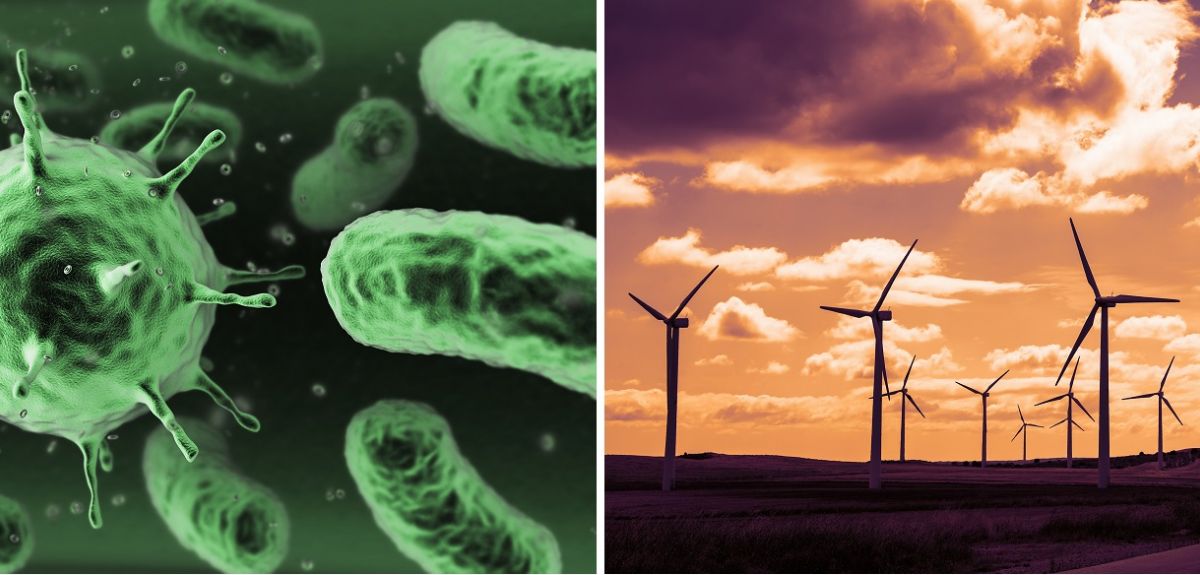
Image: Composite from Shutterstock / Shutterstock
Scientists simulate tiny bacteria-powered 'windfarm'
A team of scientists from Oxford University has shown how the natural movement of bacteria could be harnessed to assemble and power microscopic 'windfarms'.
The study, published in the journal Science Advances, uses computer simulations to demonstrate that the chaotic swarming effect of dense active matter such as bacteria can be organised to turn cylindrical rotors and provide a steady power source.
Researchers say these biologically driven power plants could someday be the microscopic engines for tiny, man-made devices that are self-assembled and self-powered.
Co-author Dr Tyler Shendruk, from Oxford University's Department of Physics, said: 'Many of society's energy challenges are on the gigawatt scale, but some are downright microscopic. One potential way to generate tiny amounts of power for micromachines might be to harvest it directly from biological systems such as bacteria suspensions.'
Dense bacterial suspensions are the quintessential example of active fluids that flow spontaneously. While swimming bacteria are capable of swarming and driving disorganised living flows, they are normally too disordered to extract any useful power from.
But when the Oxford team immersed a lattice of 64 symmetric microrotors into this active fluid, the scientists found that the bacteria spontaneously organised itself in such a way that neighbouring rotors began to spin in opposite directions – a simple structural organisation reminiscent of a windfarm.
Dr Shendruk added: 'The amazing thing is that we didn’t have to pre-design microscopic gear-shaped turbines. The rotors just self-assembled into a sort of bacterial windfarm.
'When we did the simulation with a single rotor in the bacterial turbulence, it just got kicked around randomly. But when we put an array of rotors in the living fluid, they suddenly formed a regular pattern, with neighbouring rotors spinning in opposite directions.'
Co-author Dr Amin Doostmohammadi, from Oxford University's Department of Physics, said: 'The ability to get even a tiny amount of mechanical work from these biological systems is valuable because they do not need an input power and use internal biochemical processes to move around.
'At micro scales, our simulations show that the flow generated by biological assemblies is capable of reorganising itself in such a way as to generate a persistent mechanical power for rotating an array of microrotors.'
Senior author Professor Julia Yeomans, from Oxford University's Department of Physics, added: 'Nature is brilliant at creating tiny engines, and there is enormous potential if we can understand how to exploit similar designs.'
The paper 'Active micromachines: Microfluidics powered by mesoscale turbulenceence' is published in Science Advances.
 New study estimates NHS England spends 3% of its primary and secondary care budget on the health impacts of temperature
New study estimates NHS England spends 3% of its primary and secondary care budget on the health impacts of temperature
 International collaboration launches largest-ever therapeutics trial for patients hospitalised with dengue
International collaboration launches largest-ever therapeutics trial for patients hospitalised with dengue
 Oxford-built multi-agent assistant for cancer care to be piloted in collaboration with Microsoft
Oxford-built multi-agent assistant for cancer care to be piloted in collaboration with Microsoft
 World's first Phase II Nipah virus vaccine trial launch
World's first Phase II Nipah virus vaccine trial launch